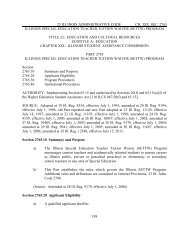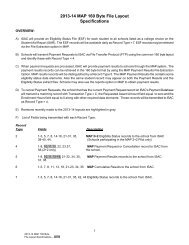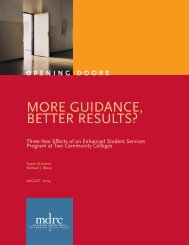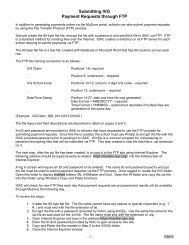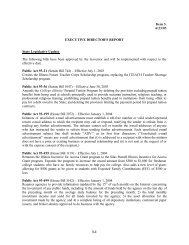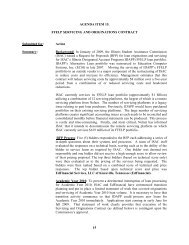High school rigor and good advice: Setting up students to succeed
High school rigor and good advice: Setting up students to succeed
High school rigor and good advice: Setting up students to succeed
Create successful ePaper yourself
Turn your PDF publications into a flip-book with our unique Google optimized e-Paper software.
References<br />
Adelman, C. (2006). The Toolbox Revisited: Paths <strong>to</strong> Degree Completion From <strong>High</strong> School Through<br />
College. Office of Vocational <strong>and</strong> Adult Education. U.S. Department of Education Retrieved on June 20,<br />
2012, from http://www2.ed.gov/rschstat/research/pubs/<strong>to</strong>olboxrevisit/<strong>to</strong>olbox.pdf<br />
Carnevale, A. P., Smith, N. <strong>and</strong> Strohl, J. (2010). Help Wanted: Projections of jobs <strong>and</strong> education<br />
requirements through 2018. Gearge<strong>to</strong>wn University Center on Education <strong>and</strong> the Workforce Retrieved<br />
on Oc<strong>to</strong>ber 4, 2012, from http://cew.george<strong>to</strong>wn.edu/jobs2018/<br />
Coleman, J. S. (1966). Equality of Education Opportunity. Johns Hopkins University Retrieved on from<br />
Conley, D. T. (2007). Redefining College Readiness. Education Policy Improvment Center Retrieved on<br />
June 20, 2012, from http://www.aypf.org/documents/RedefiningCollegeReadiness.pdf<br />
CPE. (2012). Is <strong>High</strong> School Tough Enough:. Center for Public Education Retrieved on July 11, 2012, from<br />
http://www.centerforpubliceducation.org/Main-Menu/Instruction/Is-high-<strong>school</strong>-<strong>to</strong>ugh-enough-At-aglance<br />
Knapp, L. G., Kelly-Reid, J. E. <strong>and</strong> Ginder, S. A. (2012). Enrollment in Postsecondary Institutions, Fall<br />
2011; Financial Statistics, Financial Year 2011; Graduation Rates, Selected Cohorts 2003 - 2008 (NCES<br />
2012-174). National Center for Education Statistics, U.S. Department of Education Retrieved on from<br />
http://nces.ed.gov/pubs2012/2012174.pdf<br />
National Center for <strong>High</strong>er Education Management Systems (NCHEMS). Retention Rates - First-Time<br />
College Freshmen Returning Their Second Year. Retrieved on Oc<strong>to</strong>ber 4, 2012, from<br />
http://www.higheredinfo.org/dbrowser/index.php?submeasure=228&year=2010&level=&mode=policy<br />
&state=0<br />
1 In 2010, there were 3.2 million first-time freshmen enrolled in 2- <strong>and</strong> 4-yr colleges. 90% would be 2.88 million for<br />
each of the next 8 years or 23 million graduates, 4.2 million shy of the president’s goal.<br />
2 Calculated based on data from Education Longitudinal Study (ELS) 2002-2006<br />
3 ELS Variable Description: Socio-economic status composite, v.2, BYSES2 was previously named SES2 on the BY<br />
ECB. 1989 GSS occ<strong>up</strong>ational prestige scores used instead of 1961<br />
Duncan SEI-version.<br />
4 Variable Name: F1SES2, F1 socio-economic status composite, v.2<br />
5 Variable Name: BYTXCSTD, St<strong>and</strong>ardized test composite score math/reading<br />
6 Variable Name: F1SES2, F1 socio-economic status composite, v.2<br />
21



